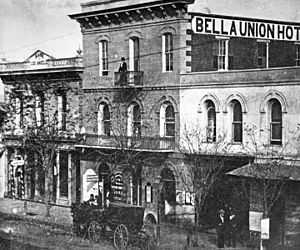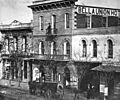Bella Union Hotel facts for kids
Quick facts for kids Bella Union Hotel |
|
|---|---|

Circa 1873 view of the Bella Union Hotel
|
|
| Location | East of Temple and Main streets, where Fletcher Bowron Square is today |
| Built | 1835 |
| Demolished | 1940 |
| Architect | William Wolfskill, Joseph Paulding and Richard Laughlin |
| Reference no. | 656 |
The Bella Union Hotel in Los Angeles, California, was built in 1835. It is recognized as California Historical Landmark No. 656. This building was very important in the history of Mexican California. It served as the last official meeting place for Governor Pío Pico from 1845 to 1847. For many years, it was a central spot for social gatherings and political discussions in Los Angeles. The hotel was located on N. Main Street, just north of Commercial Street. Over time, it was also known as the Clarendon and later the St. Charles.
Contents
A Look Back: The Bella Union Hotel's Story
How the Hotel Began
The Bella Union Hotel was built near where a large Tongva (or Kizh) village called Yaanga once stood. In 1835, three American trappers named William Wolfskill, Joseph Paulding, and Richard Laughlin built the original one-story adobe building. It was first a home for Isaac Williams, a merchant who came to Los Angeles in 1832.
Serving as a Government Building
This simple adobe house became very important when Governor Pío Pico bought it. He used it as his main office, making it the last "capital" building of Mexican Alta California. After American troops took control of Los Angeles in 1847, Lieutenant Archibald H. Gillespie, who led the troops, used the building. It even served as a place for soldiers to stay.
From Hotel to Courthouse and More
By early 1850, the building opened as the Bella Union Hotel. Later that same year, it became Los Angeles County's very first courthouse.
Starting in 1858, the hotel became a major travel center for the region. The Overland Mail Company, founded by John Butterfield (who also started American Express), rented space there. Wells Fargo also had an office at the hotel. Plus, Phineas Banning ran coaches from the hotel to places like Wilmington and San Bernardino.
The hotel grew over time. A second floor was added in 1851, and a third floor was built in 1869.
New Names and New Looks
In 1873, the hotel was renamed the Clarendon Hotel. It got many updates, including a new lounge with reading and chess tables. A special stairway was built for ladies to reach the dining room, which could seat 100 guests. The hotel expanded, connecting to another building with 16 rooms. This made the hotel stretch from Main Street to Los Angeles Street along Commercial Street. In early 1875, the hotel changed its name again to the St. Charles.
Important Moments at the Bella Union Hotel
A Capital City and Early Government
- When Pío Pico became the official governor of California in 1845, he moved the capital from Monterey to Los Angeles. He set up his main office in the building that later became the Bella Union Hotel.
- After American forces took over California in 1847, Lieutenant Archibald Gillespie used the building. After the troops left, it became a public gathering place.
- In early 1850, the building opened as the Bella Union Hotel. On June 24, 1850, it became Los Angeles County's first courthouse. It served this purpose until late 1851 or 1852.
Travel and Communication Hub
- On October 7, 1858, the very first Butterfield Overland Mail stagecoach arrived from the East. It had traveled for 21 days from St. Louis, Missouri. This made the hotel a key spot for travel and communication. Wells Fargo and Phineas Banning's coaches also operated from here.
- In 1860, the hotel hosted a celebration for the first telegraph message sent between San Francisco and Los Angeles. This was a big step for communication!
A Place for Different Views
- During the American Civil War in 1861, the Bella Union was a popular meeting spot for people who supported the Southern Confederacy. Because of this, Union soldiers were not allowed to enter.
- In 1861, Albert Sidney Johnston, a general who had resigned from the U.S. Army, stayed at the Bella Union. He was on his way to join the Confederate forces.
Changes and New Owners
- Henry Hammel owned the Bella Union in 1862 or 1863. He later sold his share and moved to Kern County, California, during a gold rush. There, he and Andrew H. Denker built another hotel, also called the Bella Union.
- In 1868, the hotel became the temporary home of Robert Maclay Widney, who is known as the "father of the University of Southern California." He and his wife stayed there until their new house was ready.
- In 1870, people learned that the old adobe parts of the hotel would be removed for remodeling. About 80 important citizens gathered for a farewell dinner on June 30, 1870. John King was the owner at that time.
- The improvements were finished in 1873, and the hotel's name changed to the Clarendon.
- Finally, in 1875, the hotel became the St. Charles. It offered lower-priced lodging to a growing and diverse population.
Early Technology Demonstration
- In April 1877, the first talk over a telephone wire in Los Angeles happened near the St. Charles. A U.S. Signal Corps lieutenant strung 200 feet of wire from the St. Charles to the Lafayette Hotel across the street. A local newspaper described it as "quite a toy and very interesting."
The End of an Era
The Bella Union Hotel building was torn down in 1940. The site was then turned into a parking lot.
California Historical Landmark
The California Historical Landmark Marker No. 656 at the site tells us:
- NO. 656 BELLA UNION HOTEL SITE - Near this spot stood the Bella Union Hotel, long a social and political center. Here, on October 7, 1858, the first Butterfield Overland Mail stage from the east arrived 21 days after leaving St. Louis. Warren Hall was the driver, and Waterman Ormsby, a reporter, the only through passenger.
Images for kids


